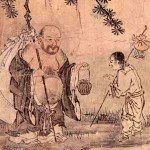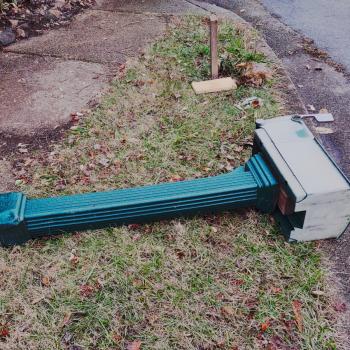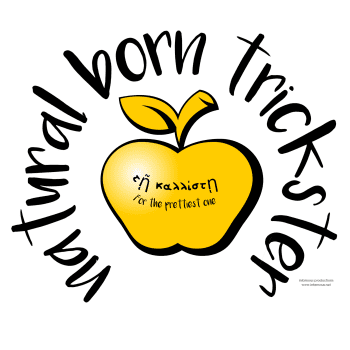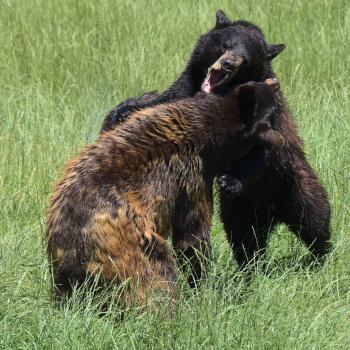I don’t blame you for being scared of guns.
The banner for this blog is a collage, and the leftmost image is clipped from a 10th century painting from Dunhuang of the story of the Buddha’s temptation by Mara. (I tell that story in Why Buddha Touched the Earth)
In the upper right of the painting we can see that one of the demons menacing the Buddha-to-be is holding a primitive firearm, a fire lance. This is the first known portrayal of a firearm[Tanner, 204] — showing it as the tool of a horrible demon. (Another demon holds a primitive grenade.)
When firearms were first introduced, they were slow and inaccurate and probably less directly lethal than bows and arrows. But they were loud, incredibly loud, and produced great quantities of smoke. They were terrifying. An army with firearms had the thunder at its command.[Bartusis, 335]
Guns, in other words, are supposed to be scary. That’s been the idea from the start.
Now, if you happen to be behind the gun, using it to scare off or stop people intent on harming you or your family or your town or nation, this is a very good thing. It is the righteous fury of a wrathful deity, the power of Fudō-myōō “whose powers are of lava, of magma, of deep rock strata, of gunpowder, and the Sun,” as Gary Snyder put it.[Snyder, 17]
These wrathful deities are common in Buddhist iconography and mythology, and are often said to be demons or similar figures who were converted and became protectors of the dharma. Traditionally they are armed with swords or other ancient weapons but there’s no reason we might not reflect the reality of our times and give a modern wrathful deity a firearm. If all sentient beings are eventually liberated, someday that demon in the Dunhuang painting with the fire lance will see the light and will stand beside all those sword-wielding Bodhisattvas as a guardian.
But if you’ve never even contemplated having to connect to that wrathful deity energy, if you’ve been privileged (or, bluntly, naive) enough to never have had to consider the possibility that you or those you love could be the intended victim of serious and implacable violence, if you’ve never thought of yourself in a situation where your only choices might be the defensive use of deadly force or death, it is understandable if you find firearms frightening.
However, to go from “guns kind of scare me” to “I’m scared of my neighbors having guns and want laws to stop it” is a profoundly undemocratic sentiment. Fear is no legitimate basis for policy making.
(“But wait!” you may exclaim. “Aren’t you invoking fear when you talk about threats to our loved ones? And isn’t at least some part of American gun culture is based on unreasoning fear, on racism and xenophobia?” But there is a large difference between being prepared and being afraid. And there is much about gun culture I find disturbing, from those who treat firearms as holy talismans of freedom to gun shop commandos who seem anxious for a chance to shoot someone; but I preach to one group of sinners at a time.)
I won’t blame you for being afraid of guns. But if you take a political stance based on that fear without making the effort to understand the basic facts about firearms and crime, if you are prepared to threaten people with state violence — for the threat of violence is the root of the law, it’s why police and prison guards have guns and clubs — if you are ready to threaten people with violence to get them to give up the tools of defense in an ineffective scheme to reduce criminal violence…that, I will blame you for.
If you talk about “assault weapons” without understanding that this is a political term invented to conflate modern firearms that merely have a military appearance with the sort of fully automatic “assault rifles” that are in military use[Kobayashi, 43-46] and which are, essentially, already banned for civilian ownership…that, I will blame you for.
If you talk about “gun deaths” without distinguishing between suicides (the majority of deaths by firearm, more than 60%[Cohn, 11]), homicides, and accidents (rare), I will blame you for that.
If you believe the myth that the typical murderer is someone with no prior history of violence who suddenly snaps, picks up a gun, and kills someone,[Kates, 666-669; Hermann] I will blame you for that.
If you compare the U.S. rate of violent crime to that of other nations and cherry-pick only other rich developed nations, if you do not realize that in so doing you’re confirming that socioeconomic factors are more important causes of violence than firearms, I will blame you for that. And if you do not take into account that more than 30% of our murders do not involve guns,[Cohn 12] that we stab and beat and choke each other at a higher rate than do rich nations that lack our history of racism and economic injustice, I will blame you for that.
If you try to misapply the methods of the biological problem of disease control to the criminological problem of violence, I will blame you for that. Crime is not a disease (80s action movie taglines notwithstanding) and firearms are not disease vectors.
The “infection” or “public health” metaphor cannot take into account that a person may own a firearm because they perceive a threat of crime and don’t trust the state to protect them. It can’t process that many people buy guns for the same reason that they put bars on their windows — that gun ownership is often a result of violent crime, rather than a cause. It is a form of “self-help”, as sociologists term it.[Smith, 101]
If you talk about an “epidemic” of violence despite the fact that the violent crime rate is down to roughly one-third of what it was twenty years ago,[Truman] I will blame you for that.
If you call for more and harsher penalties for technical violations of gun laws (as opposed to penalties for actual violence) without understanding the racial disparity in enforcement and prosecution, if you do not understand how such laws contribute to the mass incarceration of black and brown people[Balko, Covert], I will blame you for that.
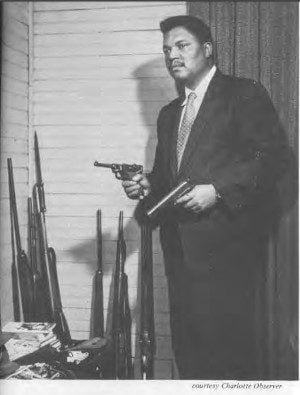
If you have not taken into account the role that armed self-defense played in the struggle for equality and civil rights, how black men and women in the South took up arms during the 20th century to actively resist racist terrorism (including violence from government officials),[Cobb 111, 188, 190, 197-198, 207, 216-217] if your idea of gun ownership does not include a shotgun-toting W.E.B. DuBois saying “If a white mob had stepped on the campus where I lived I would without hesitation have spread their guts over the grass,”[Cobb 70] I will blame you for that.
If you believe that citizens can rely on the police for protection from violence, if you do not understand the truth of the cliche that “when seconds count the police are minutes away”, if you do not know that numerous court cases up through the Supreme Court have ruled that the police have no obligation to even show up when you call,[Greenhouse; Kick] I will blame you for that.
If you ignore the role of firearms in self-defense and community defense, if you neglect the thousands of defensive uses of firearms a year by ordinary citizens — estimates range from 108,000 to 3,000,000[IOM, 15] (and yes that’s a huge error bar), I will blame you for that. If you haven’t considered that at least four times this year armed citizens carrying handguns have protected innocent people against active shooters in public places in Philadelphia[Chang]; Covington, Georgia[Rand]; Chicago[Ziezulewicz]; and Cincinnati[Butts] (plus stopping a gun-toting bank robber in Warren, Michigan[Wimbley] — and this is by no means a complete list), I will blame you for that.
And if you want people on the “no-fly” list — an secretive and error-ridden database created by the surveillance state with no regard for due process[Smith] — to be stripped of their rights, I will blame you for that.
Fear is an understandable emotional response to reports of violence. But democracy demands reasoned responses that take into account all the relevant facts and that respect the basic rights of others. And that includes the most basic human right of all, self-defense. For democracy does not merely mean majority rule, it means treating each of our fellow citizens as fellow sovereigns, with all the rights, honors, and privileges appertaining thereunto.
Am I saying that there is nothing to be done to reduce violence? Of course not. I am libertarian (small-l) but I am also a progressive (small-p), and I firmly believe that we can do a better job of meeting every human being’s needs, from basic survival needs all the way up Maslow’s hierarchy to self-actualization.
But just as after a century of failure we are finally coming to understand that drug prohibition laws do nothing to reduce drug abuse and in fact make the problem worse, that all that effort was not only wasted but counter-productive, so we must understand that firearm prohibition laws do not reduce violence and may make the problem worse.
As the Discordians say, “Imposition of Order = Escalation of Disorder.” The Law of Eristic Escalation is not a joke; or rather, it’s not only a joke. It’s a basic truth of governance: the more you tighten your grip, the more slips through your fingers.
Useful approaches to social problems rely on modeling responsible behavior — and it is here that matters of the spirit come into play — and on identifying irresponsible people and putting them under supervision. They do not rest upon scapegoating inanimate objects.
Such scapegoating is an ancient tradition; the ancient Greeks would banish swords used to murder, and in the Anglo-America legal tradition all sorts of objects deemed responsible for deaths were destroyed as “deodands” — swords, wells, trees, boats, chains, statues, even a steam engine.[Kopel 15-16]
As ritual this is an interesting way to attempt to exert symbolic control over the world; but as governance it’s lousy — “magical thinking” in the worst sense.
References
Balko, Radley. “Shaneen Allen, race and gun control.” Washington Post: The Watch, 22 Jul 2014. https://www.washingtonpost.com/news/the-watch/wp/2014/07/22/shaneen-allen-race-and-gun-control/
Bartusis, Mark C. The Late Byzantine Army: Arms and Society, 1204-1453. Philadelphia: University of Pennsylvania Press, 1992. https://books.google.com/books?id=rUs-hHd89xAC&pg=PA335
Butts, Rebecca. “Police: Man protects family in gunfight.” Cincinnati Enquirer, 27 Jul 2015. http://www.cincinnati.com/story/news/2015/07/27/police-man-protects-family–gunfight/30725313/
Chang, David. “Gunman Shot, Killed Inside West Philly Barbershop.” NBC 10 Philadelphia, 22 Mar 2015. http://www.nbcphiladelphia.com/news/local/Man-Shot-in-the-Chest-Inside-West-Philly-Barbershop-297176271.html
Cobb, Charles E. This Nonviolent Stuff’ll Get You Killed. New York: Basic Books, 2014.
Cohn, D’Vera, et al. “Gun Homicide Rate Down 49% Since 1993 Peak; Public Unaware.” Washington D.C.: Pew Research Center, May 7, 2013. http://www.pewsocialtrends.org/2013/05/07/gun-homicide-rate-down-49-since-1993-peak-public-unaware/
Covert, Bryce. “Race, Gun Control and Unintended Consequences.” The Nation. 15 Jan 2013. http://www.thenation.com/article/race-gun-control-and-unintended-consequences/
Greenhouse, Linda. “Justices Rule Police Do Not Have a Constitutional Duty to Protect Someone” New York Times. 28 Jun 2005. http://www.nytimes.com/2005/06/28/politics/justices-rule-police-do-not-have-a-constitutional-duty-to-protect-someone.html
Hermann, Peter. “Baltimore murder victims, suspects share ties to criminal justice system.” Baltimore Sun. 2 Jan 2012. http://www.baltimoresun.com/news/breaking/bs-md-ci-homicide-analysis-20120102-story.html
IOM (Institute of Medicine) and NRC (National Research Council). Priorities For Research to Reduce the Threat of Firearm-Related Violence. Washington, DC: The National Academies Press, 5 Jun 2013. http://www.nap.edu/read/18319/chapter/3#15
Kates, Don B. and Gary Mauser. “Would Banning Firearms Reduce Murder and Suicide? A Review of International and Some Domestic Evidence.” Harvard Journal of Law & Public Policy, Vol 30 Number 2 (Spring 2007). http://www.law.harvard.edu/students/orgs/jlpp/Vol30_No2_KatesMauseronline.pdf
Kick, Russ. “The Police Aren’t Legally Obligated To Protect You.” Disinfo.com. 5 Mar 2010. http://disinfo.com/2010/03/the-police-arent-legally-obligated-to-protect-you/
Kobayashi, Bruce H. and Joseph E. Olson. “In Re 101 California Street: A Legal and Economic Analysis of Strict Liability for the Manufacture and Sale of ‘Assault Weapons'”. Stanford Law & Policy Review, Vol. 8, p. 41, 1997. http://ssrn.com/abstract=2070920
Kopel, David B. “The Ideology of Gun Ownership and Gun Control in the United States.” Quarterly Journal of Ideology 18, 1995, 3-34. https://www.researchgate.net/publication/252857426_THE_IDEOLOGY_OF_GUN_OWNERSHIP_AND_GUN_CONTROL_IN_THE_UNITED_STATES
Smith, Douglas A., and Craig D. Uchida. “The Social Organization of Self-help: A Study of Defensive Weapon Ownership”. American Sociological Review 53.1 (1988): 94–102. http://www.jstor.org/stable/2095735
Rand, Martin III. “Covington man who fired back at Magnet store shooter called ‘hero’.” Covington News, 2 Jun 2015. http://www.covnews.com/archives/59620/
Smith, David. “‘The illusion of security’: no-fly list draws scrutiny from left and right.” The Guardian, 9 Dec 2015. http://www.theguardian.com/us-news/2015/dec/09/no-fly-list-errors-gun-control-obama
Snyder, Gary. “Spel Against Demons.” Turtle Island. New York: New Directions, 1974. 17 https://books.google.com/books?id=xilff6LAWAcC
Tanner, Harold Miles. China: A History, Volume 1: From Neolithic cultures through the Great Qing Empire. Indianapolis: Hackett Publishing Company, 2010. https://books.google.com/books?id=2lzuCgAAQBAJ&pg=PA204
Truman, Jennifer L. and Lynn Langton. “Criminal Victimization, 2014”. U.S. Department of Justice Bureau of Justice Statistics, August 2015. NCJ 248973. http://www.bjs.gov/content/pub/pdf/cv14.pdf
Wimbley, Randy. “Bank robber hospitalized after being shot three times by customer.” WJBK Fox 2 Detroit, 21 Sep 2015 / 23 Sep 2015. http://www.fox2detroit.com/news/local-news/23024347-story
Ziezulewicz, Geoff. “Uber driver, licensed to carry gun, shoots gunman in Logan Square” Chicago Tribune, 20 Apr 2015. http://www.chicagotribune.com/news/local/breaking/ct-uber-driver-shoots-gunman-met-0420-20150419-story.html
You can keep up with “The Zen Pagan” by subscribing via RSS or e-mail.
Have I mentioned my book lately? Why Buddha Touched the Earth makes a great Yule gift for the Zen Pagan on your list.
If you do Facebook, you might choose to join a group on “Zen Paganism” I’ve set up there. And don’t forget to “like” Patheos Pagan and/or The Zen Pagan over there,
too.




